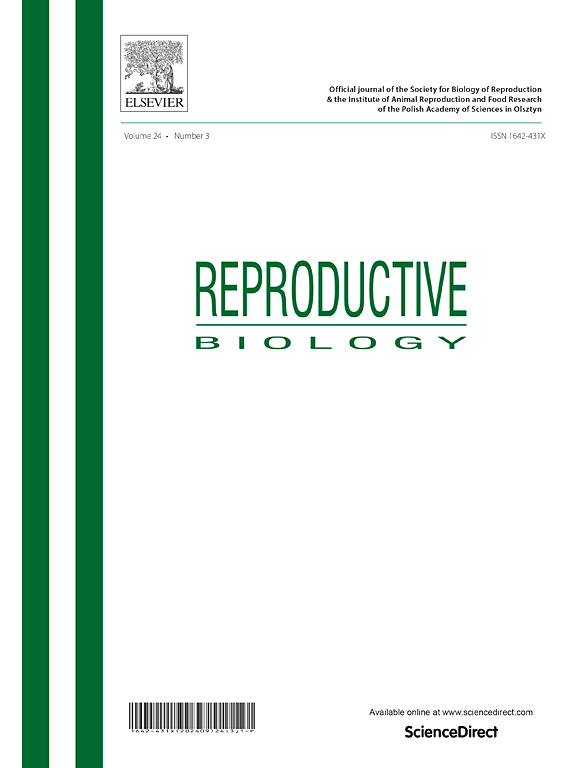The postnatal offspring of finasteride-treated male rats show altered ERα and PCNA expression in the liver
IF 2.5
3区 生物学
Q3 REPRODUCTIVE BIOLOGY
引用次数: 0
Abstract
A growing body of data indicates that the physiology of the liver is sex-hormone dependent, with some types of liver failure occurring more frequently in males, and some in females. In males, in physiological conditions, estrogens acts via estrogen receptors (ERs). Estrogen may promote liver tumorigenesis, due to the increased hepatocyte mitogenic activity or may cause regression of hypertrophic liver nodules or, as in the case of hepatic adenocarcinoma, may reduce the estrogen-binding ability of hepatocytes. In our previous studies, we demonstrated biochemical changes in blood parameters as well as physiological and morphological changes in the liver of male rats from the paternal generation receiving finasteride. Therefore, the goal of the study was to assess whether the administration of finasteride has an intergenerational effect on ERα and PCNA (to detect mitotic activity) expression in the hepatocytes of male rat offspring. The study was conducted on the liver from immature (7, 14, 21, 28 days age) and mature (90 days age) Wistar male rats (F1:Fin) born by females fertilized by finasteride-treated rats. The control group was the offspring (F1:Control) of untreated Wistar parents. After the IHC reaction, the slides were undergoing Quantitative Computer Image Analysis. We demonstrated an altered pattern of immunoexpression level of the studied markers in the F1:Control vs F1:Fin groups. We noticed a positive (F1:Control 7PND, postnatal days) and negative (F1:Control 90PND) correlation between ERα and PCNA immunoexpression. Additionally, the expression of ERα and PCNA was examined at the mRNA level. This paper is documenting that finasteride use by paternal generation males (in reproductive age) may lead to an intergenerational effect detrimental to the liver function of their male offspring.
非那雄胺处理的雄性大鼠出生后的后代肝脏中ERα和PCNA表达发生改变
越来越多的数据表明,肝脏的生理机能依赖于性激素,有些类型的肝功能衰竭更常发生在男性身上,有些更常发生在女性身上。在男性中,在生理条件下,雌激素通过雌激素受体(er)起作用。由于肝细胞有丝分裂活性的增加,雌激素可能促进肝脏肿瘤的发生,也可能导致肥厚性肝结节的消退,或者像在肝腺癌的情况下,可能降低肝细胞的雌激素结合能力。在我们之前的研究中,我们证明了父亲代的雄性大鼠接受非那雄胺后血液参数的生化变化以及肝脏的生理和形态变化。因此,本研究的目的是评估非那雄胺给药是否对雄性大鼠后代肝细胞中ERα和PCNA(检测有丝分裂活性)表达有代际影响。本研究采用未成熟(7、14、21、28日龄)和成熟(90日龄)Wistar雄性大鼠(F1:Fin)与非那雄胺处理大鼠受精后所生的肝脏。对照组为未处理Wistar亲本的后代(F1: control)。免疫组化反应后,对载玻片进行定量计算机图像分析。我们证明了F1:Control组与F1:Fin组中所研究标记物的免疫表达水平的改变模式。我们注意到ERα和PCNA免疫表达呈正相关(F1:对照7PND,出生后)和负相关(F1:对照90PND)。在mRNA水平上检测ERα和PCNA的表达。本文记录了父亲代男性(育龄期)使用非那雄胺可能导致对其男性后代肝功能有害的代际效应。
本文章由计算机程序翻译,如有差异,请以英文原文为准。
求助全文
约1分钟内获得全文
求助全文
来源期刊

Reproductive biology
生物-生殖生物学
CiteScore
3.90
自引率
0.00%
发文量
95
审稿时长
29 days
期刊介绍:
An official journal of the Society for Biology of Reproduction and the Institute of Animal Reproduction and Food Research of Polish Academy of Sciences in Olsztyn, Poland.
Reproductive Biology is an international, peer-reviewed journal covering all aspects of reproduction in vertebrates. The journal invites original research papers, short communications, review articles and commentaries dealing with reproductive physiology, endocrinology, immunology, molecular and cellular biology, receptor studies, animal breeding as well as andrology, embryology, infertility, assisted reproduction and contraception. Papers from both basic and clinical research will be considered.
 求助内容:
求助内容: 应助结果提醒方式:
应助结果提醒方式:


